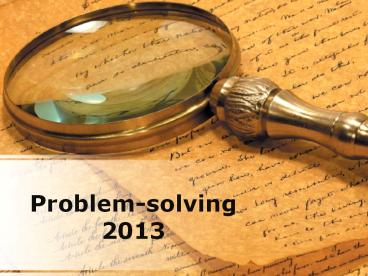Problem Solving PowerPoint Content - PowerPoint PPT Presentation
Title:
Problem Solving PowerPoint Content
Description:
ReadySetPresent (Problem Solving PowerPoint Presentation Content): 100+ PowerPoint presentation content s. There are many approaches to problem solving, depending on the nature of the problem and the people involved. – PowerPoint PPT presentation
Number of Views:12821
Title: Problem Solving PowerPoint Content
1
Problem-solving2013
2
Problem-solving Cycle (1 of 5)
3
Program Objectives (1 of 2)
- Be prepared to actively listen in order to
accurately understand the problem. - Know how to take the first step in solving a
problem. - Clarify and define the problem.
- Understand the usefulness of collaborative
problem-solving and decision-making.
4
Program Objectives (2 of 2)
- Examine different decision making models.
- Utilize creativity in the problem-
solving/decision-making process. - Plan, practice, and problem-solve while making
decisions through case studies, role playing and
group discussions.
5
Definitions (1 of 3)
- Problem-solving.
- A systematic approach to defining the problem
(question or situation that presents uncertainty,
perplexity or difficulty) and creating a vast
number of possible solutions without judging
these solutions.
6
Definitions (2 of 3)
- Decision-making
- The act of narrowing down the possibilities,
choosing a course of action, and determining the
actions potential consequences.
7
Definitions (3 of 3)
- Problem-solving is a cognitive processing
directed at achieving a goal where no solution
method is obvious to the problem-solver. - Critical Thinking Defined
- Purposeful mental activity that helps formulate
or solve problems, make decisions, or fulfill a
desire to understand.
8
Problem-solving Cycle (2 of 5)
- Identify the problem You must be aware of the
problem to be able to work on it. - Understand the problem You must understand every
aspect of the problem in order to figure out the
best way to solve it.
9
Understanding the ProcessHow to Solve it
10
Understanding the Process How to Solve it (3 of
7)
- Understand the problem.
- Put in the time to define the problem
- Discuss.
- Ask questions.
- Visualize.
- Restate the problem in your own words.
- Explain the problem to someone else.
11
Learning These Skills
- Obtain the basic knowledge of the facts and the
ways of doing things. - Metacognition Understand how one uses what one
knows. - Heuristics Develop strategies and techniques to
find easier approaches to related problem. - A Can-Do Attitude This problem can be solved
(positive attitude).
12
Group or Individual Brainstorming (1 of 2)
- Problem-solving skills will be discovered,
recognized and drawn upon within a group. - When there is a time limit, individuals will be
faster! - Groups provide an opportunity for greater
innovation.
13
Beware
14
Beware
- One of the more subtle problems in communication
is the perception that all printed or spoken
information is factual. Let facts alone influence
you, and you will make better decisions.
15
Collaborative Problem Solving (2 of 6)
- Step 1 Gather Information
- Ignore arguments and proposals.
- Examine the facts, figures and information.
- Identify missing information and how to get it.
- Construct a thorough and accurate definition of
the problem.
16
SWOT Analysis (1 of 7)
- What is SWOT?
- S Strengths
- W Weaknesses
- O Opportunities
- T Threats
17
What is your next step?
18
- Download Problem-Solving PowerPoint
presentationat ReadySetPresent.com153 slides
include 4 points on definitions of problem
solving, 5 slides on the problem solving cycle,
15 points on teaching problem solving, 34 points
on understanding the process, 5 points on
defining the problem, 5 points on brainstorming,
13 points on a scientific approach to data,
solution, and reflection, 4 points on learning
skills, 5 points on understanding the problem, 6
points on past experience and future problems, 5
points on learning from the past, 7 primary
issues for problem solvers, 8 active listening
techniques, 14 points on active listening, 5
points on group perspective, 4 essential steps of
creative problem solving, 6 points on group or
individual brainstorming, 10 points on problem
solving framework, 23 points on the problem
solving process, 4 quotes on what is decision
making, 10 factors for making effective
decisions, 7 points on styles and approaches, 6
Cs of decision making, 10 traps in an inherent
system, 7 points on decision making methods, 6
points on vertical thinking, 7 points on lateral
thinking, 7 creative thinking environments, 10
points on adaptors and innovators, 9 points on
collaborative problem solving, 4 requirements of
group problem solving, 22 points on 5 steps of
collaborative problem solving, 5 points on
leadership and creative work environments, 8
points on triggers for inspiration, 5 points on
sacred cows, 20 points on 4 modes of problems
solving, 4 techniques, 16 points on S.W.O.T.
analysis, and finally 16 action steps. - Royalty Free - Use Them Over and Over Again.
- Updated Expanded 2013
- Now more content, graphics, and diagrams

